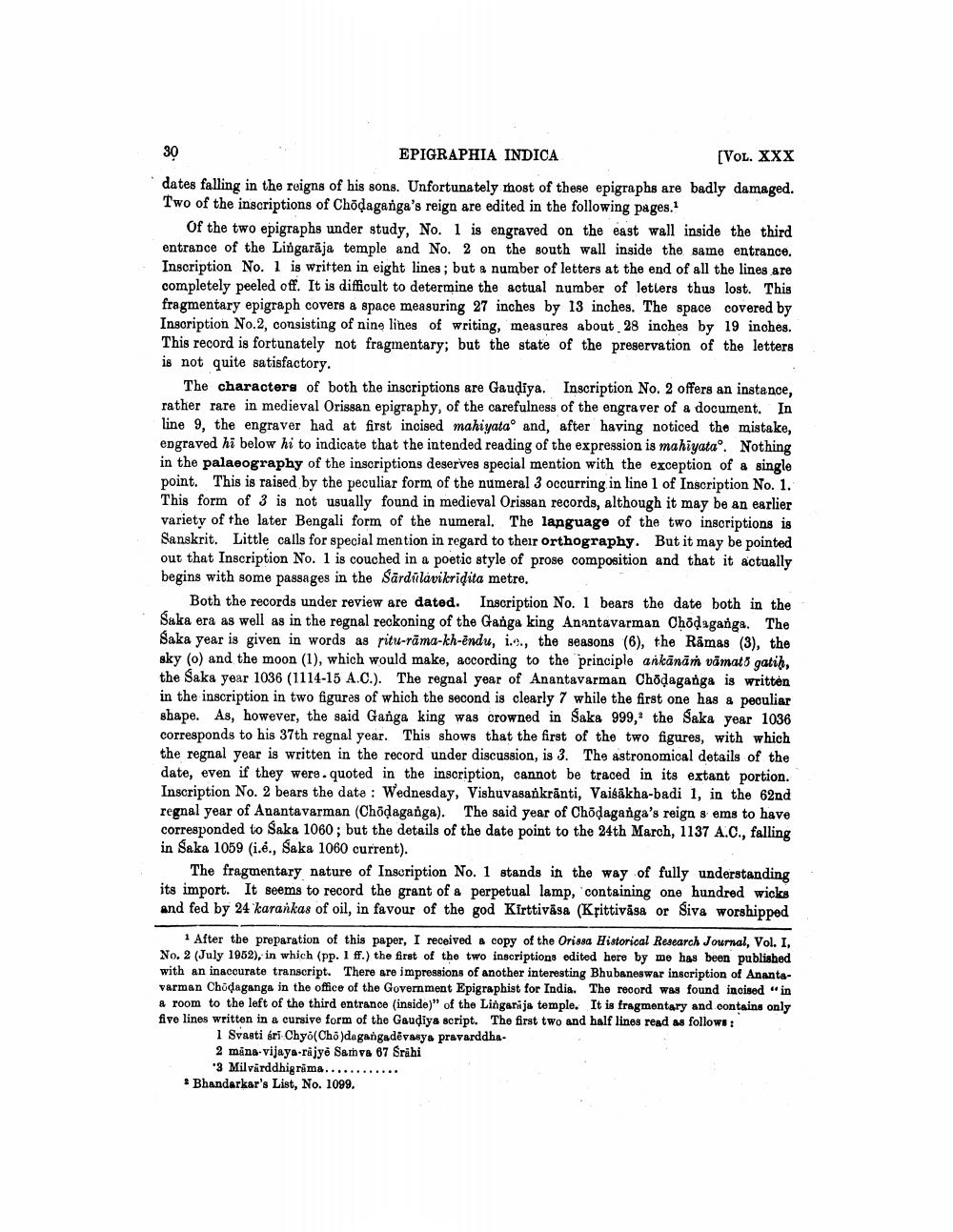________________
30
EPIGRAPHIA INDICA
[VOL. XXX
dates falling in the reigns of his sons. Unfortunately most of these epigraphs are badly damaged. Two of the inscriptions of Chōdaganga's reign are edited in the following pages.1
Of the two epigraphs under study, No. 1 is engraved on the east wall inside the third entrance of the Lingaraja temple and No. 2 on the south wall inside the same entrance. Inscription No. 1 is written in eight lines; but a number of letters at the end of all the lines are completely peeled off. It is difficult to determine the actual number of letters thus lost. This fragmentary epigraph covers a space measuring 27 inches by 13 inches. The space covered by Inscription No.2, consisting of nine lines of writing, measures about 28 inches by 19 inches. This record is fortunately not fragmentary; but the state of the preservation of the letters is not quite satisfactory.
The characters of both the inscriptions are Gauḍīya. Inscription No. 2 offers an instance, rather rare in medieval Orissan epigraphy, of the carefulness of the engraver of a document. In line 9, the engraver had at first incised mahiyata and, after having noticed the mistake, engraved hi below hi to indicate that the intended reading of the expression is mahiyata. Nothing in the palaeography of the inscriptions deserves special mention with the exception of a single point. This is raised by the peculiar form of the numeral 3 occurring in line 1 of Inscription No. 1. This form of 3 is not usually found in medieval Orissan records, although it may be an earlier variety of the later Bengali form of the numeral. The language of the two inscriptions is Sanskrit. Little calls for special mention in regard to their orthography. But it may be pointed out that Inscription No. 1 is couched in a poetic style of prose composition and that it actually begins with some passages in the Sardulávikridita metre.
Both the records under review are dated. Inscription No. 1 bears the date both in the Saka era as well as in the regnal reckoning of the Ganga king Anantavarman Chōdaganga. The Saka year is given in words as ritu-rama-kh-endu, i.e., the seasons (6), the Ramas (3), the sky (o) and the moon (1), which would make, according to the principle ankānāṁ vämato gatiḥ, the Saka year 1036 (1114-15 A.C.). The regnal year of Anantavarman Chodaganga is written in the inscription in two figures of which the second is clearly 7 while the first one has a peculiar shape. As, however, the said Ganga king was crowned in Saka 999, the Saka year 1036 corresponds to his 37th regnal year. This shows that the first of the two figures, with which the regnal year is written in the record under discussion, is 3. The astronomical details of the date, even if they were. quoted in the inscription, cannot be traced in its extant portion. Inscription No. 2 bears the date: Wednesday, Vishuvasankranti, Vaisakha-badi 1, in the 62nd regnal year of Anantavarman (Chōḍaganga). The said year of Chōdaganga's reign s ems to have corresponded to Saka 1060; but the details of the date point to the 24th March, 1137 A.C., falling in Saka 1059 (i.é., Saka 1060 current).
The fragmentary nature of Inscription No. 1 stands in the way of fully understanding its import. It seems to record the grant of a perpetual lamp, containing one hundred wicks and fed by 24 karankas of oil, in favour of the god Kirttiväsa (Krittiväsa or Siva worshipped
1 After the preparation of this paper, I received a copy of the Orissa Historical Research Journal, Vol. I, No. 2 (July 1952), in which (pp. 1 ff.) the first of the two inscriptions edited here by me has been published with an inaccurate transcript. There are impressions of another interesting Bhubaneswar inscription of Anantavarman Chōdaganga in the office of the Government Epigraphist for India. The record was found incised "in a room to the left of the third entrance (inside)" of the Lingarija temple. It is fragmentary and contains only five lines written in a cursive form of the Gaudiya script. The first two and half lines read as follows:
1 Svasti ári Chyō(Cho)dagangadevasya pravarddha
2 mana vijaya-rajye Samva 67 Srāhi
3 Milvärddhigrama....
Bhandarkar's List, No. 1099.




